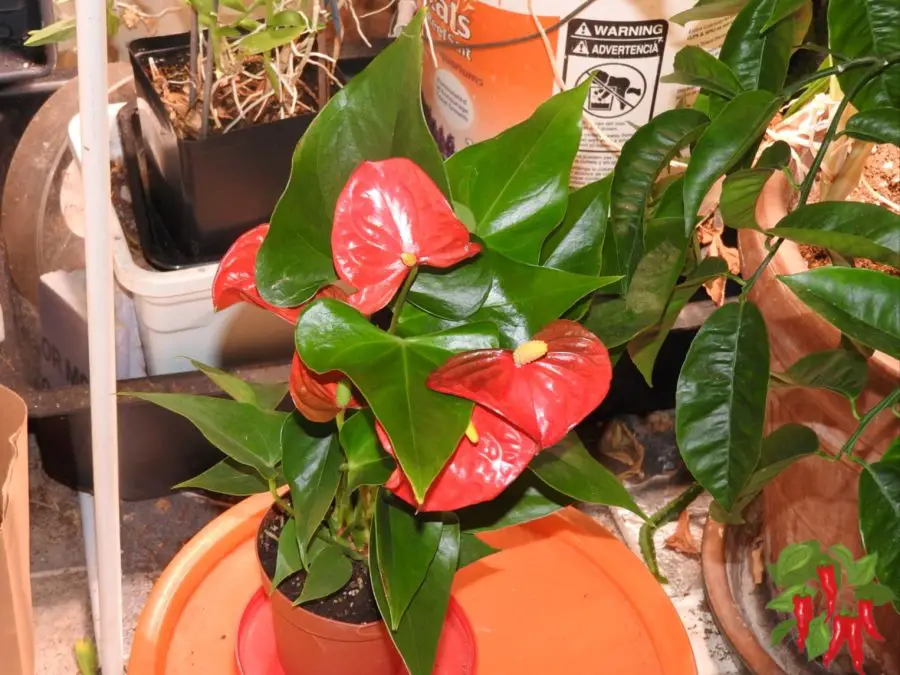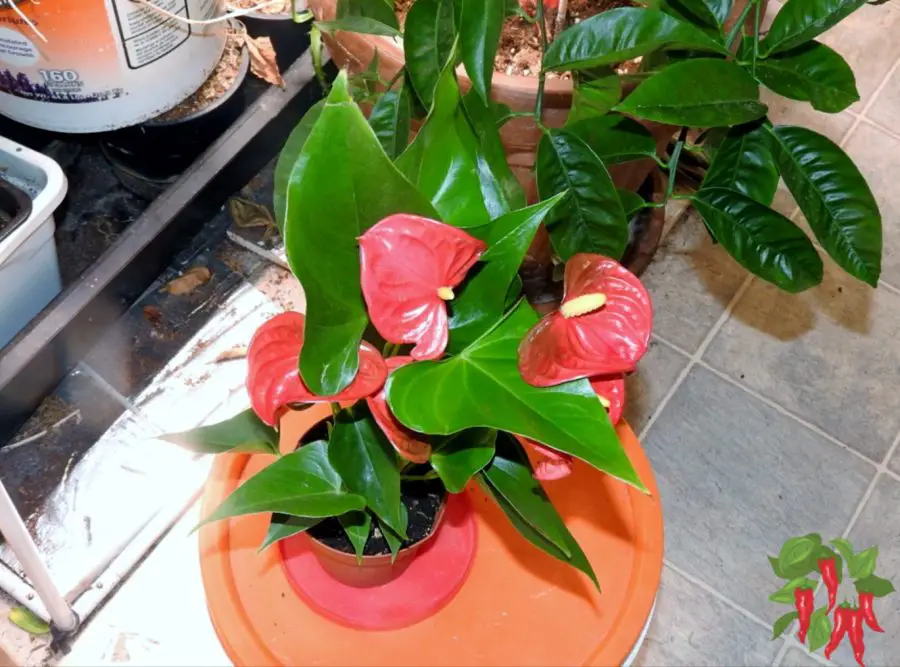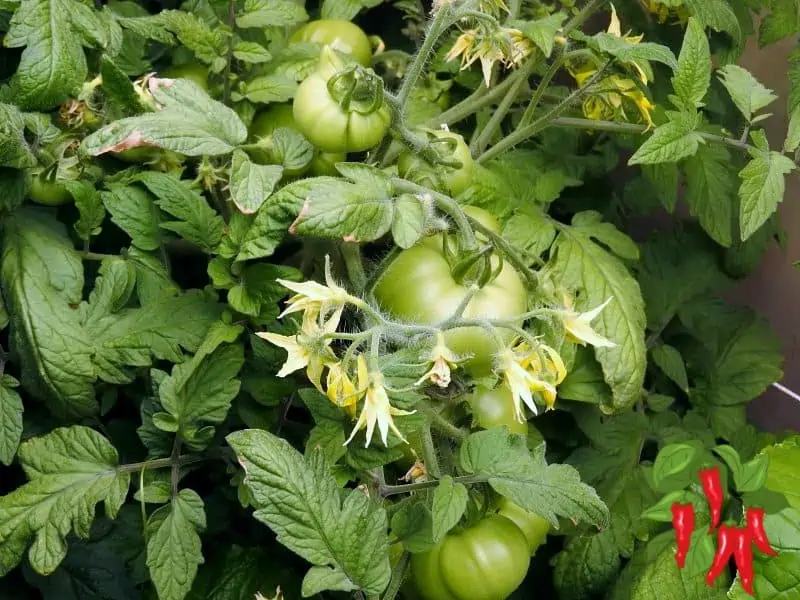This post may contain affiliate links. If you buy something from one of our links we may earn a commission. Thanks

Red Anthurium plant care might seem tricky, but it’s easier than you think! Ever brought home one of these stunning tropical beauties, only to watch it slowly lose its luster? Don’t worry – with a few simple tips, you’ll have your Anthurium thriving in no time, filling your space with vibrant color and exotic flair.
Red Anthurium Plant Care Key Takeaways
- Red Anthurium plant care involves:
- Providing bright, indirect light,
- Maintaining high humidity,
- And watering when the top inch of soil feels dry.
- These tropical plants thrive in warm temperatures between 70-90°F.
- Feed monthly with a balanced fertilizer during the growing season for vibrant, long-lasting blooms.
How To Grow and Care for Red Anthurium Video

California Tropicals Anthurium Red – Live House Plants Indoor, 4 Inch Pot for Easy Care, Perfect for Office, Home & Flamingo Decor, Real Plant, Plant Gift, Flowering Plants, Sympathy Flowers
Red Anthurium Plant Care: Your Ultimate Guide to Growing Vibrant Blooms
Red Anthuriums, with their glossy heart-shaped leaves and vibrant scarlet blooms, are a stunning addition to any indoor garden space.
These tropical beauties, also known as Flamingo Flowers or Laceleaf, are prized for their long-lasting flowers and relatively easy care requirements.
In this comprehensive guide, we’ll explore everything you need to know about red Anthurium plant care, from ideal growing conditions to troubleshooting common issues.
Whether you’re a seasoned plant enthusiast or a beginner looking to add a touch of exotic charm to your home, this article will equip you with the knowledge to help your Anthurium thrive and produce those signature eye-catching blooms year after year.
1. How to Take Care of Anthurium Plants Indoors

Anthuriums are well-suited for indoor cultivation, making them popular houseplants. To ensure your red Anthurium thrives in an indoor environment, consider the following care tips:
Ideal Indoor Conditions:
• Light: Bright, indirect light is crucial for Anthuriums. Place them near a north or east-facing window for optimal light exposure without risking leaf burn.
• Humidity: These tropical plants thrive in high humidity environments. Aim for 60-80% humidity by using a humidifier, placing a pebble tray filled with water beneath the pot, or grouping plants together.
• Temperature: Maintain temperatures between 70-90°F (21-32°C) during the day and no lower than 60°F (15°C) at night.
Watering Techniques:
• Water thoroughly when the top 1-2 inches of soil feel dry to the touch.
• Ensure proper drainage to prevent water from pooling around the roots.
• Use room temperature water to avoid shocking the plant.
Best Practices for Potting and Soil Mix:
• Use a well-draining potting mix specifically designed for aroids or create your own by combining equal parts peat moss, pine bark, and perlite.
• Choose a pot with drainage holes to prevent water accumulation.
• Repot every 2-3 years or when the plant outgrows its current container.
2. Red Anthurium Plant Care: Watering
Proper watering is crucial for the health of your red Anthurium. Here’s what you need to know:
How Often to Water:
• Allow the top 50% of the soil to dry out between waterings.
• Typically, this means watering once a week during the growing season and less frequently in winter.
• Adjust watering frequency based on environmental factors like humidity and temperature.
Signs of Overwatering vs. Underwatering:
Overwatering:
• Yellowing leaves, especially at the base of the plant
• Soft, mushy stems
• Mold growth on soil surface
Underwatering:
• Drooping or wilting leaves
• Dry, crispy leaf edges
• Slow growth or lack of new leaves
Ideal Water Quality and pH Levels:
• Use filtered or distilled water if your tap water is high in minerals.
• Anthuriums prefer slightly acidic soil with a pH between 5.5 and 6.5.
• If using tap water, let it sit out overnight to allow chlorine to evaporate.
3. How to Plant Anthurium in Pots
Choosing the Right Pot:
• Select a pot 1-2 inches larger in diameter than the current one when repotting.
• Ensure the pot has adequate drainage holes.
• Terracotta or clay pots are ideal as they allow excess moisture to evaporate.
Soil Composition:
• Use a light, well-draining potting mix rich in organic matter.
• A mixture of orchid bark, peat moss, and perlite works well.
• Add a handful of charcoal to the mix to improve drainage and prevent soil compaction.
Steps for Repotting:
• Water the plant thoroughly a day before repotting.
• Gently remove the plant from its current pot, being careful not to damage the roots.
• Trim any dead or rotting roots with clean, sharp scissors.
• Place a layer of fresh potting mix in the new pot.
• Position the plant in the center of the new pot and fill in with potting mix.
• Water lightly and place in a shaded area for a few days to recover.
4. Red Anthurium Plant Care Outdoor
While Anthuriums are primarily indoor plants, they can be grown outdoors in tropical or subtropical climates:
Growing Anthuriums Outdoors:
• Plant in a location with filtered sunlight or partial shade.
• Ensure soil is well-draining and rich in organic matter.
• Maintain consistent moisture but avoid waterlogged soil.
Protection from Harsh Elements:
• Shield plants from direct sunlight, especially during the hottest part of the day.
• Protect from strong winds that can damage leaves and dry out the plant.
• Bring plants indoors or provide protection when temperatures drop below 60°F (15°C).
Seasonal Adjustments:
• Increase watering frequency during hot, dry periods.
• Reduce watering in cooler months to prevent root rot.
• Apply a balanced, water-soluble fertilizer monthly during the growing season.
5. Anthurium Plant Problems
Common Issues:
• Root Rot: Caused by overwatering or poor drainage. Symptoms include yellowing leaves and soft, mushy stems.
• Yellowing Leaves: Can indicate overwatering, underwatering, or nutrient deficiencies.
• Pest Infestations: Spider mites, aphids, and mealybugs are common pests.
Solutions for Pests:
• Spider Mites: Increase humidity and spray leaves with water regularly. Use neem oil for severe infestations.
• Aphids: Remove with a strong stream of water or apply insecticidal soap.
• Mealybugs: Dab with alcohol-soaked cotton swabs and treat with neem oil.
Preventive Measures:
• Maintain proper watering habits and avoid overwatering.
• Ensure adequate air circulation around the plant.
• Regularly inspect plants for early signs of pest infestation.
6. Anthurium Care for Brown Leaves
Causes of Brown Leaves:
• Underwatering: Leaves become dry and crispy, especially at the edges.
• Low Humidity: Can cause browning of leaf tips and edges.
• Too Much Direct Sunlight: Causes scorching and browning of leaves.
How to Fix and Prevent:
• Adjust watering schedule to maintain consistent soil moisture.
• Increase humidity by misting leaves, using a pebble tray, or running a humidifier.
• Move the plant to a location with bright, indirect light away from direct sun exposure.
• Trim off severely damaged leaves to encourage new growth.
7. How Long Do Anthurium Plants Live?
Lifespan of an Anthurium:
• With proper care, Anthuriums can live for several years, typically 5-7 years or more.
• Some well-maintained plants have been known to thrive for decades.
Maintaining Long-Term Health:
• Provide consistent care, including proper light, water, and humidity levels.
• Repot every 2-3 years to refresh soil and provide room for growth.
• Prune regularly to remove old or damaged foliage and encourage new growth.
Encouraging Frequent Blooming:
• Ensure the plant receives adequate bright, indirect light.
• Fertilize monthly during the growing season with a phosphorus-rich fertilizer.
• Maintain proper humidity levels to support flower development.
8. Red Anthurium Plant Benefits
Aesthetic Appeal:
• Striking red flowers that can last up to 6-8 weeks.
• Glossy, heart-shaped leaves provide year-round visual interest.
• Versatile plant suitable for various interior design styles.
Air Purification Qualities:
• Anthuriums are known to remove harmful indoor air pollutants like formaldehyde and ammonia.
• They can help improve indoor air quality and create a healthier living environment.
Symbolic Meaning:
• In feng shui, Anthuriums are believed to bring good luck and positive energy.
• The heart-shaped flowers symbolize hospitality, happiness, and abundance.
Limited Medicinal Use:
• Some cultures have traditionally used Anthurium leaves for medicinal purposes, though scientific evidence is limited.
• Note: All parts of the Anthurium plant are toxic if ingested, so caution is advised.
Red Anthurium Plant Care FAQs
Q: How do you take care of a red Anthurium plant?
A: Red Anthuriums require bright, indirect light, well-draining soil, and moderate watering. Keep them in temperatures between 70-90°F (21-32°C) and maintain high humidity. Fertilize monthly during the growing season and repot every 2-3 years.
Q: Where is the best place to put an Anthurium?
A: The best location for an Anthurium is near a north or east-facing window where it can receive bright, indirect light. Avoid placing it in direct sunlight, which can scorch the leaves.
Q: How often should I water my Anthurium?
A: Water your Anthurium when the top 50% of the soil feels dry. This typically means watering once a week during the growing season and less frequently in winter. Adjust based on your specific environment.
Q: How long do red Anthuriums last?
A: Individual Anthurium blooms can last up to 6-8 weeks. With proper care, the plant itself can live for 5-7 years or more, continually producing new flowers throughout its lifetime.
Q: How do you keep anthuriums blooming?
A: To encourage blooming, provide bright, indirect light, fertilize monthly with a phosphorus-rich fertilizer during the growing season, and maintain high humidity. Ensure the plant has a period of slightly cooler temperatures in winter to stimulate flower production.
Q: Should I deadhead an Anthurium?
A: Yes, deadheading spent flowers is beneficial. It encourages the plant to produce more blooms and maintains a tidy appearance. Simply cut the flower stalk close to the base when the bloom fades.
Q: How do I get my Anthurium to flower again?
A: Ensure your Anthurium receives enough bright, indirect light and regular fertilization. Maintain proper humidity and allow for a slight temperature drop in winter. Be patient, as it may take several months for new blooms to develop.
Q: What are the signs of overwatering Anthurium?
A: Signs of overwatering include yellowing leaves (especially at the base of the plant), soft or mushy stems, and mold growth on the soil surface. The plant may also show signs of wilting despite wet soil.
Q: How many times do anthuriums bloom?
A: Anthuriums can bloom multiple times per year under ideal conditions. Each bloom can last several weeks, and with proper care, the plant can produce new flowers throughout the year, with peak blooming typically occurring in spring and summer.
Caring for Red Antrhuriums Conclusion
Red Anthuriums are truly remarkable plants that can bring a touch of tropical elegance to any space.
By following the care guidelines outlined in this article, you can ensure your Anthurium not only survives but thrives, rewarding you with its stunning red blooms for years to come.
Remember to pay attention to your plant’s specific needs, adjusting care as necessary based on your home’s environment.
With the right balance of light, water, humidity, and nutrients, your red Anthurium will flourish, becoming a centerpiece in your indoor garden.
Don’t be discouraged if you encounter challenges along the way – many common Anthurium issues can be easily resolved with prompt attention and care.
Embrace the journey of nurturing your Anthurium, and enjoy the beauty and benefits this remarkable plant brings to your life.
Wrapping Up Your Anthurium Adventure
Now that you’re equipped with all the essentials of red Anthurium plant care, you’re ready to embark on your journey as an Anthurium enthusiast.
Remember, every plant is unique, and it might take a little time to find the perfect balance in your specific environment.
Don’t be afraid to experiment and adjust your care routine as needed.
Propagating Your Anthurium
Want to expand your Anthurium collection? Learn how to propagate your plant through division or stem cuttings. It’s a fun way to create new plants and share with friends!
Seasonal Care Tips
Discover how to adjust your Anthurium care routine throughout the year. From winter rest periods to summer growth spurts, we’ve got you covered.
Companion Plants for Anthuriums
Explore other tropical plants that pair beautifully with your Anthurium and share similar care requirements. Create your own indoor jungle!
Key Takeaways:
• Bright, indirect light is crucial for healthy growth and vibrant blooms
• Maintain high humidity through misting, pebble trays, or a humidifier
• Water when the top inch of soil is dry, and ensure good drainage
• Feed monthly during the growing season with a balanced fertilizer
• Repot every 2-3 years to refresh soil and provide room for growth
• Regular pruning encourages new growth and maintains plant shape
• Monitor for pests and address issues promptly for a thriving Anthurium
By following these guidelines, you’ll be well on your way to becoming an Anthurium expert. Enjoy the journey and the beautiful, long-lasting blooms your care will produce!
Visit my Amazon Influencer Page for videos and gardening products Grow Your Own Garden






